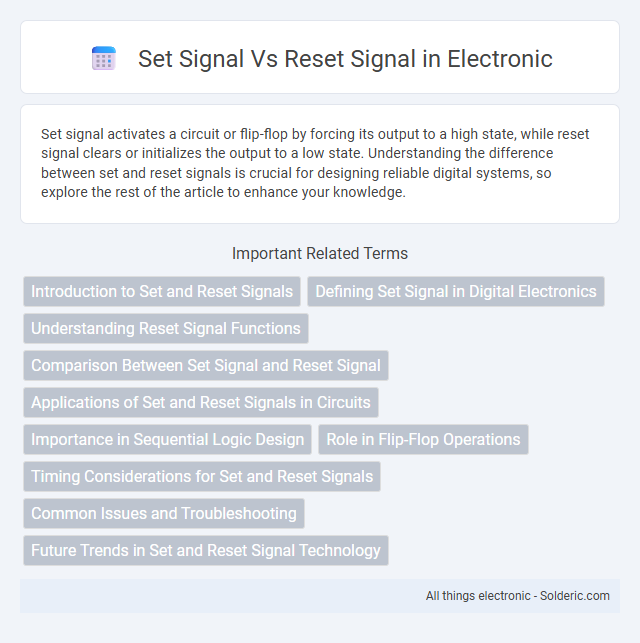Set signal activates a circuit or flip-flop by forcing its output to a high state, while reset signal clears or initializes the output to a low state. Understanding the difference between set and reset signals is crucial for designing reliable digital systems, so explore the rest of the article to enhance your knowledge.
Comparison Table
| Feature | Set Signal | Reset Signal |
|---|---|---|
| Definition | Activates or turns a circuit/component ON | Deactivates or turns a circuit/component OFF |
| Primary Function | Sets the output state to HIGH (1) | Resets the output state to LOW (0) |
| Usage | Initialize or enable signals/devices | Clear or disable signals/devices |
| Typical Logic Level | Logic HIGH or active HIGH | Logic LOW or active LOW |
| Common Circuits | Flip-flops, latches, control registers | Flip-flops, latches, control registers |
| Effect on Output | Output transitions to 1 | Output transitions to 0 |
Introduction to Set and Reset Signals
Set and reset signals are fundamental in digital electronics for controlling bistable circuits like flip-flops and latches, defining the output state as either high or low. A set signal forces the output to a logic high state, while a reset signal compels it to a logic low state. Your understanding of these signals is crucial for designing reliable memory and control systems, ensuring accurate state management in sequential logic devices.
Defining Set Signal in Digital Electronics
The set signal in digital electronics is a control input used to force a flip-flop or latch into a specific state, typically setting its output to logic high (1). It is an asynchronous signal, meaning it overrides other inputs regardless of clock timing, ensuring the device immediately enters the desired state. Your understanding of the set signal is essential for designing reliable digital circuits that require precise state initialization and control.
Understanding Reset Signal Functions
A reset signal initializes a system or device by returning it to a known default state, ensuring stable operation after power-up or fault conditions. Unlike a set signal that activates or enables specific functions, the reset signal clears all active states and prepares the system for fresh inputs. Understanding reset signal functions helps you design reliable hardware and software that can recover efficiently from errors or interruptions.
Comparison Between Set Signal and Reset Signal
Set signals activate a device or logic circuit to a high or active state, while reset signals return it to a low or default state, ensuring reliable initialization. The set signal is often used to initiate operations or latch data, whereas the reset signal clears errors and prepares the system for a fresh start. Understanding your circuitry's reliance on these signals helps optimize performance and prevent unintended states.
Applications of Set and Reset Signals in Circuits
Set and reset signals are essential in flip-flops and latches used in digital memory and storage applications for initializing or clearing data states. These signals enable precise control in control systems, ensuring reliable startup conditions or emergency shutdown states. They are also integral to counters and shift registers for synchronizing operations and maintaining system stability during state transitions.
Importance in Sequential Logic Design
Set and reset signals are critical for controlling the state of flip-flops and latches in sequential logic design, ensuring reliable storage and manipulation of binary data. Proper use of these signals prevents race conditions and metastability, which can cause unpredictable circuit behavior. Their importance is underscored in applications like registers, counters, and memory elements where precise state initialization and control are essential for system stability and performance.
Role in Flip-Flop Operations
Set signal forces the flip-flop output to logic high (1), establishing a defined state regardless of the clock input. Reset signal drives the flip-flop output to logic low (0), enabling initialization or clearing of stored data. These signals are crucial for controlling the flip-flop state during asynchronous operations and system initialization processes.
Timing Considerations for Set and Reset Signals
Proper timing of set and reset signals is crucial to avoid metastability and ensure reliable operation in sequential circuits. Set and reset inputs should be synchronized with the clock to prevent timing hazards, with setup and hold times carefully observed to maintain data integrity. Your design must account for propagation delays and signal arrival times to guarantee consistent state transitions in flip-flops and latches.
Common Issues and Troubleshooting
Set signal and reset signal commonly cause issues such as signal noise, timing mismatches, or incorrect logic levels that disrupt circuit operation. Troubleshooting involves verifying signal integrity with oscilloscopes, ensuring proper synchronization with clock signals, and checking for wiring errors or faulty components. Your ability to diagnose these problems quickly improves circuit reliability and performance.
Future Trends in Set and Reset Signal Technology
Emerging trends in set and reset signal technology emphasize low-power consumption and enhanced speed for memory and control circuits. Advanced semiconductor materials and nanotechnology enable more reliable and energy-efficient set/reset operations in flip-flops and latches. Integration with AI-driven adaptive control systems optimizes signal timing, improving overall circuit performance in next-generation electronic devices.
set signal vs reset signal Infographic

 solderic.com
solderic.com